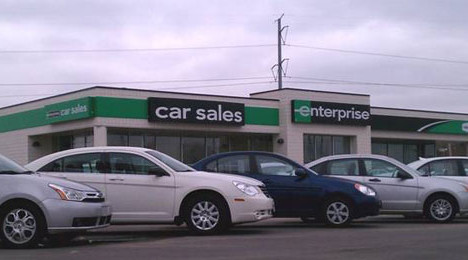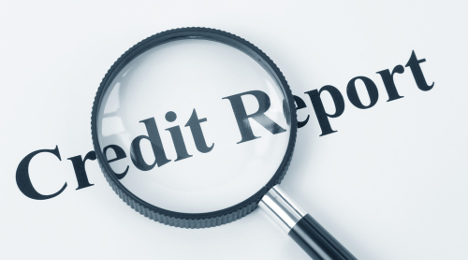Enterprise Car Sales generated a record $483 million in loan volume to more than 28,000 credit union members during 2014.
Enterprise Car Sales is a service of Enterprise Rent-A-Car, the largest rental car brand in North America, and specializes in working with credit unions of all sizes to increase auto loans. Enterprise's record loan volume reflects continued strong auto lending last year and is on trend with ongoing growth in the credit union sector overall. In fact,
Last year’s performance contributed to Enterprise Car Sales generating almost $10 billion in loan volume during the past 30 years through more than 1,000 credit union partners nationwide.
“Our partnership with credit unions goes back decades, and we're honored to serve their membership,” said Beth Wheeler, corporate director of business development at Enterprise Car Sales.
“Our credit union partners put their trust in us — and we strive to fulfill their members' transportation needs by providing exceptional service throughout their buying experience,” Wheeler continued. “It’s truly a winning combination.”
Wheeler added that Enterprise Car Sales' tailored used-vehicle buying programs create opportunities for credit unions to increase their used-loan portfolio and optimize member loyalty.
“We regularly refer our members to Enterprise Car Sales when they’re looking to purchase a used vehicle,” said Nick Wodogaza, president and chief executive officer at Palmetto Citizens Federal Credit Union, which is based in Columbia, S.C.
“Not only does Enterprise provide outstanding service, they also refer our members back to us for financing,” Wodogaza continued. “It’s a partnership that is both great for our members and great for our business.”
For more information about how Enterprise Car Sales partners with credit unions, visit www.enterprisecarsales.com/perfectpartnership.
In what should be good news for dealership F&I personnel and finance company portfolio managers, Experian Automotive reported that consumers are relying on financing more than ever to buy their next vehicle.
According to its latest State of the Automotive Finance Market report, the percentage of new vehicles purchased with financing in the fourth quarter of 2014 increased over the previous year to reach 84 percent.
Analysts also determined used vehicles that were financed reached a record high of 55.2 percent.
Furthermore, the latest Experian data showed that the average loan amount for a new vehicle in the fourth quarter of 2014 once again hit its highest level on record, reaching $28,381. This represents a more than $950 increase from a year ago and a $582 increase from the previous quarter.
For used vehicles, the average loan amount increased $437 from last year to reach $18,411.
“In most parts of the country, vehicles are viewed as a necessity to everyday life, which is why we continue to see consumers willing to take out larger loans as the average price of vehicles continues to rise,” said Melinda Zabritski, Experian’s senior director of automotive finance.
“As more consumers lean on financing, it’s important for them to consider all of the factors involved, including monthly payments, interest rates and loan terms,” Zabritski continued. “These insights will enable them to have a better understanding of their potential payment obligation and take the appropriate action in order to make the vehicle fit within their monthly budget and more easily meet payment terms throughout the life of the loan.”
Findings from the newest report also showed that leasing continued to gain traction, as it jumped 3.6 percent from a year ago to reach nearly 30 percent of all new vehicles financed in the quarter.
In addition to the number of leases increasing in the quarter, Experian indicated that it was slightly more affordable and easier to obtain one.
The average monthly lease payment decreased $12 from a year ago to reach $408 in Q4 2014.
What’s more, the average new-vehicle lessee had an average credit score of 717 in Q4 2014, down two points over the same time period.
In other Experian findings from Q4:
• The average credit score for a new-vehicle loan dropped 3 points in Q4 2014 to reach 712.
• The average credit score for a used vehicle loan increased 2 points in the quarter to reach 648.
• In the fourth quarter of 2014, the average monthly payment for a new vehicle hit $482 — its highest level on record.
• Interest rates for new-vehicle loans crept up in Q4 2014 to 4.56 percent.
• Loan terms for new and used vehicles increased from a year ago to reach 66 months and 62 months, respectively.
• Captives were the only lender type to see an increase in market share year-over-year.
A report surfacing this past weekend indicated that Wells Fargo is capping how much subprime auto paper is going to fill its portfolio going forward.
The New York Times reported Wells Fargo has decided to cap its subprime originations at 10 percent of its overall vehicle installment contract originations. The newspaper indicated bank executives determined their 2014 total originations figure came in at $29.9 billion.
The report — authored by the same individuals who have taken aim at the subprime auto finance industry in previous articles — said, “The decision, detailed in interviews with top Wells Fargo executives, along with other large auto lenders, is a sobering moment for the booming market. Other lenders may decide to take their cue from Wells Fargo, one of the nation’s largest lenders. After successfully sidestepping many of the catastrophic mortgage losses that hit its competitors during the financial crisis, the bank has developed a reputation for deftly managing risk.”
The news comes after finance companies such as Credit Acceptance watched its fourth-quarter originations expand because management chose to loosen terms. Another firm that specializes in subprime paper, Consumer Portfolio Services, also is coming off a quarter of expanding business.
When Consumer Portfolio Services reported a year-end earnings per share increase of more than 35 percent, chairman and chief executive officer Brad Bradley not only highlighted that performance, but also how the company is preparing to answer questions from the Consumer Financial Protection Bureau and the U.S. Department of Justice.
Bradley reiterated how CPS previously acknowledged that the two federal agencies are investigating the finance company in the same manner as several other operations that specialize in subprime auto financing are being reviewed. CPS already made modifications and paid a penalty after the Federal Trade Commission handed out an enforcement action last year in connection with the company’s collection practices.
“The regulatory market obviously is continuing to be more interesting by the day, and so we have spent an awful lot of time, particularly in the collection front, training everyone in terms of all the different compliance areas,” Bradley said when CPS conducted its most recent conference call with investors.
“I think we are way ahead of the curve, but nonetheless, it is the process of really making sure everything we do is compliant across the board. Because whether regulatory people look around, we want everything where it’s supposed to be,” he continued. “And so we spent a lot of time with retraining and more training and listening to calls to make sure everything is being done the right way.”
Bradley also mentioned how CPS is working to ensure the dealers in its network also are abiding by what federal regulators mandate. CPS is ramping up the effort in light of the CFPB on the lookout for disparate impact happening in auto financing.
The CPS boss explained that the finance company currently has between 8,000 and 10,000 dealers in its network for vehicle installment contract originations. Each quarter, the company calls on dealers to make sure they are compliant, and at last check, the company found less than a dozen showed any signs of disparate impact issues.
Bradley said the check-up is done to see if “there might be some disparate impact in the way they make car loans. If so, we cut them off our program and put them into a rehabilitation program at which point if they can complete that and demonstrate that there have been some changes so they can re-enter our program.
“Those kind of things I think can put us in a very strong position in terms of where we sit with all the CFPB stuff that’s coming down the pike,” Bradley continued.
Meanwhile, the Department of Justice investigation is connected more with what happens to those vehicle installment contracts after they’re originated and packed together in securitizations for the investment community, according to Bradley. Again, the top CPS executive is confident the company can navigate any questions DOJ might have, especially since CPS seems to adhere the protocol set by the industry.
“What’s a little interesting about that is as one can imagine, the investors buying those loans or the bonds, the ABS bonds, are pretty used to buying a very standardized format,” Bradley said. “And so all of the companies, including ourselves, follow those formats, and so we are all doing it basically the same.
“I think given the mortgage comparison — unfair, unkind or untrue that it may be — I think the government wants to make sure that we are not doing what the mortgage folks did, which is putting out a bunch of loans that aren’t going to be able to be paid,” he continued. “I won’t bother anyone with a long list of why the auto industry is nothing like the mortgage industry, with a small exception that all of our bonds are and as everyone else in our industry paid great to a very significant recession unlike the mortgage folks.
“And so we, I, and the rest of our industry would stand on that,” Bradley went on to say. “But even so, we will be participating in the DOJ investigation along with everyone else. And it’s very hard to say more on that subject than we already have.”
Latest Company Performance
Consumer Portfolio Services reported fourth-quarter earnings of $8.0 million, or 25 cents per diluted share. Those figures are up from $6.5 million, or 21 cents per diluted share, in the fourth quarter of last year, representing a 19-percent increase in earnings per diluted share.
The company’s full-year earnings for 2014 came in at $29.5 million, or 92 cents per diluted share, as compared to earnings of $21.0 million, or 67 cents per diluted share, for 2013. The gain represented a 37-percent spike in earnings per diluted share.
Officials indicated Q4 revenue jumped $16.9 million or 25.4 percent to $83.5 million, up from $66.6 million for the fourth quarter of 2013. They acknowledged total Q4 operating expenses rose by $14.0 million or 25.4 percent to $69.1 million, climbing from $55.1 million a year earlier.
Looking at pretax income, CPS posted a 24.4 percent increase year-over-year in the fourth quarter, generating a rise from $11.5 million to $14.3 million.
For the year, CPS’s total revenues came in at $300.3 million, up from $255.8 million in 2013. Officials pointed out that 2013 revenues included $10.9 million from a gain on cancellation of debt.
Excluding that gain, the company calculated 2014 revenues increased $55.4 million or 22.6 percent over the prior year.
CPS’ total 2014 expenses climbed from $218.6 million to $248.0 million. But the company mentioned that in 2013 its operating expenses included a provision for contingent liabilities of $7.8 million.
Excluding the provision for contingent liabilities, the company’s operating expenses for 2014 increased $37.2 million or 17.7 percent compared to the prior year period.
CPS determined its 2014 pretax income came in at $52.2 million, up from $37.2 million.
During the fourth quarter, CPS purchased $264.4 million of new contracts compared to $279.3 million during the third quarter of 2014 and $173.4 million during the fourth quarter of last year.
The company's managed receivables totaled $1.644 billion as of Dec. 31, an increase from $1.519 billion as of Sept. and $1.231 billion as of the close of 2013.
CPS reported that its annualized net charge-offs for Q4 stood at 6.44 percent of the average owned portfolio as compared to 5.57 percent a year earlier.
The company’s delinquencies greater than 30 days (including repossession inventory) were 7.18 percent of the total owned portfolio, up from 6.87 percent as of the end of 2013.
As previously reported during December, CPS closed its fourth term securitization transaction of 2014 and its 15th transaction since April 2011.
In the senior subordinate structure, a special purpose subsidiary sold five tranches of asset-backed notes totaling $267.5 million. The notes are secured by automobile receivables purchased by CPS and have a weighted average effective coupon of approximately 3.07 percent.
That transaction has initial credit enhancement consisting of a cash deposit equal to 1.00 percent of the original receivable pool balance. The final enhancement level requires accelerated payment of principal on the notes to reach overcollateralization of 4.00 percent of the then-outstanding receivable pool balance.
Officials highlighted the transaction was CPS’ third consecutive senior subordinate securitization to receive a triple-A rating on the senior class of notes.
“We are pleased to report another successful year in 2014,” Bradley said. “In addition to record pre-tax earnings, our new contract purchases grew 24 percent compared to 2013 and our total managed portfolio grew 34 percent to over $1.6 billion.
“We recorded our third consecutive year of earnings growth and continued our strategy of deleveraging our balance sheet by repaying over $49 million in residual and corporate debt without refinancing,” he added.
The latest Equifax analysis of the subprime auto finance industry triggered memories of when auto finance leader Lou Loquasto first began his professional career. Not only did Equifax call the subprime auto space “sound,” but analysts also found data that clearly backed up the claim, which they shared in a report titled, Subprime Auto Loans: A Second Chance at Economic Opportunity.
Equifax determined that over a three-year time period, those consumers with deep subprime credit scores that originated a subprime auto loan showed, in aggregate, a significant increase in their credit score.
In fact, analysts highlighted those consumers improved their credit score by a median of 52 points, which is a 62.5-percent improvement over the median score change of the group that did not take out a loan.
Even more telling, Equifax noticed those consumers who took out a subprime auto loan were four times more likely than those who did not to have improved their score to a level above 640, moving them out of the subprime segment.
The data trends prompted Loquasto to say, “I started my career sitting across the loan desk from thousands of nonprime families in need of a vehicle — each of them having a story about circumstances that resulted in their less than perfect credit score.
“It was rewarding to watch these customers diligently make the most of these second chances and see a high percentage graduate to a prime credit standing — empowering them to take full advantage of their newfound financial well-being,” he added.
With only a few short years separating today from the depths of the Great Recession, report authors — Equifax chief economist Amy Crews Cutts and deputy chief economist Dennis Carlson — acknowledged it is natural and prudent to be skeptical of the recent increase in subprime auto lending.
“Nevertheless, it is imperative that this curiosity be answered with data and not anecdotes, particularly given the benefit our analysis shows that subprime auto lending brings to those consumers who exited the recession with blemishes on their credit,” Crews Cutts and Carlson wrote. “And when the data available today is examined, it becomes clear that there is no definitive evidence that suggests an auto subprime loan bubble similar to the housing bubble is forming.
“This does not mean that we have eliminated all risk from consumer auto lending, but the new tools and technology available today, along with heightened awareness of what contributed to the housing bubble formation, enable lenders to better manage risk, and contribute to a very different subprime auto lending market today,” they continued.
Subprime auto finance naysayers likely will point to the latest data from the Federal Reserve of New York, which reported this week that auto loan delinquencies for the entire credit spectrum ticked up to 3.5 percent in the fourth quarter. That reading is up from 3.1 percent a year earlier.
“Without question, vigilance is the watchword,” Crews Cutts and Carlson wrote. “We must closely monitor the lending environment for indications of changing conditions. However, without access to quality and reputable subprime lending, borrowers will seek alternative, less dependable sources of credit — which could ultimately hurt them.
“In a world where there is a great deal of consternation regarding the stagnation of the middle class, subprime auto lending can provide help to consumers with less than perfect credit so they can improve their financial standing — and their future,” they continued.
The Equifax economists also rehashed points they made in a report released last summer, reiterating that there is not a subprime auto finance “bubble,” and comparing vehicle installment contracts to mortgages is like comparing, “apples and oranges.”
Crews Cutts and Carlson said, “The auto industry’s success wouldn’t be what it is today if it weren’t for the responsible, solid subprime loans made to the many Americans in need of a car to get to their jobs or take their children to school.
Lenders now have better tools, more data and enhanced technology available to them to make sounder and safer decisions,” they continued. “While we should all continue to remain vigilant, we can confidently say that subprime auto lending is currently performing well, it’s not growing as quickly as prime lending, and our data does not suggest that a bubble is forming.”
The National Automotive Finance Association is again enhancing its annual Non-Prime Auto Finance Survey; this time by collaborating with the American Financial Services Association.
The NAF Association and AFSA announced this week they will be working jointly to orchestrate the only survey specifically focused on the subprime auto financing market. For the past 18 years, the results have been used by companies for benchmarking, identifying trends and supporting and guiding policy decisions.
The survey is conducted by Benchmark Consulting International, which gathers and aggregates all the survey data confidentially. The data is gathered via a Web survey and incorporates Experian and Factor Trust data extracted from their traditional and alternative data credit reporting databases.
The two companies stratify and analyze the data according to their non-prime market segments specifically for the survey. This combination of information provided by AFSA and NAF Asscoation members along with Experian and Factor Trust data will provide a comprehensive overview of the industry.
Participating companies will be given a free copy of the final report.
“The NAF Association has always been motivated to get the highest level of non-prime auto finance company participation in the survey,” NAF Association executive director Jack Tracey told SubPrime Auto Finance News. “We reached out to AFSA with the thought that with the two organizations behind the campaign we could increase participation.
“Historically we’ve gotten around 25 companies submitting data, but we felt that if we could increase the number of companies submitting information that the survey results would more accurately reflect industry trends,” Tracey continued. “The NAF Association enjoys the opportunity to work with AFSA when the combination of our efforts benefit the auto financing industry.”
When contacted by SubPrime Auto Finance News, AFSA shared a similar sentiment.
“We believe the Non-Prime Auto Finance Survey is an excellent resource, and we hope that making it a joint effort between AFSA and NAF will prompt the participation of more auto finance companies,” AFSA president and chief executive officer Chris Stinebert said. “Increased participation will enhance the value of the survey and the aggregated data it provides the industry.”
For more information or how to participate, contact Tracey at (410) 865-5431 or jtracey@nafassociation.com.
AFSA Updates White Paper on Vehicle Franchise Ancillary Product Legislation
In other news, AFSA’s state government affairs committee issued a white paper earlier this week focusing on a trend in vehicle franchise legislation that affects the relationship between manufacturers, sources of vehicle finance and dealers relating to the sale of ancillary products. These products include vehicle service contracts, guaranteed asset protection (GAP) waivers and extended warranties.
AFSA highlighted the paper summarizes legislation proposed in New Jersey and Virginia and enacted in Florida, Mississippi, New York and Oklahoma during the last year. The bills include provisions prohibiting a manufacturer (or affiliated financial institution) from coercing or requiring a dealer to sell or sell exclusively their ancillary products or take action against a dealer for offering third-party products.
In some cases, AFSA noted that the provisions prohibit captive finance companies from offering exclusivity incentives to the dealer, offering finance terms to a consumer for an affiliated product that are not offered at the same time for a similar third-party product and/or requiring the dealer to disclose to the consumer when it is a third-party product.
AFSA members can download the white paper by going to this website.
The average vehicle installment contract term Credit Acceptance originated during the fourth quarter ticked up to 48.5 months. The loosening of terms helped the company generate almost 20 percent more contract volume during Q4 as Credit Acceptance’s active dealer network also jumped above 7,200 during the year.
Chief executive officer Brett Roberts gave a simple answer as to why Credit Acceptance opted to climb about the four-year threshold for its contracts.
“The term in the fourth quarter, it’s just a function of our policy so we got more generous on the term policy,” Roberts said during a conference call after Credit Acceptance shared its Q4 and full-year financial statement. “That's something that really continues a trend that started when I joined the company back in 1991. We did a 24-month term that was the max term that we would do and we've gradually inched that up over the past 25 years so now we will do a longer term and in the fourth quarter we rolled out a policy which we had experimented with which resulted in longer terms.
“We probably wouldn't lengthen the term if we were growing 20 or 30 percent and competition was light,” he continued. “It’s something that you do when the environment is more difficult, and so we did it. It’s calculated. It’s something that we’ve done many times before, and we’re comfortable we can price it.”
All told, Credit Acceptance originated 55,716 contracts during the fourth quarter and 223,998 contract for the year; figures that represented increases of 19.4 percent and 10.8 percent respectively. The company closed the year with 7,247 active dealers, an amount 13.3 percent higher year-over-year.
Credit Acceptance considers an active dealer to be one who has received funding for at least one dealer loan or purchased loan during the period.
Roberts was hesitant to say whether the fourth-quarter origination performance would create a deluge of paper filling Credit Acceptance’s portfolio.
“I think it's hard to say if it's a continuing trend. I mean it is a nice data point,” Roberts said. “It was a good quarter from a volume perspective but I think it’s too early to conclude whether it’s just an aberration or whether it’s something that will continue in the future.”
Top-Line Performance
Credit Acceptance reported consolidated net income of $73.0 million, or $3.45 per diluted share, for the three months that ended Dec. 31 compared to consolidated net income of $65.9 million, or $2.80 per diluted share, for the same period in 2013.
For the year, the company indicated its consolidated net income came in at $266.2 million, or $11.92 per diluted share, compared to $253.1 million, or $10.54 per diluted share, in 2013.
The company’s Q4 adjusted net income, a non-GAAP financial measure, totaled $69.4 million, or $3.28 per diluted share. A year earlier it was $64.3 million, or $2.73 per diluted share. For all of 2014, adjusted net income rose to $271.7 million, or $12.17 per diluted share, compared to $248.3 million, or $10.34 per diluted share, a year earlier.
During the fourth quarter, Credit Acceptance explained that it enhanced methodologies for forecasting the timing of future collections and future dealer holdback payments on loans through the utilization of more recent data, different segmentations and new forecast variables.
Officials indicated implementation of the enhanced forecasting methodologies increased consolidated net income and adjusted net income by $2.2 million and $0.6 million, respectively, for both the quarter and year end.
Completion of $300.6 Million in Asset-Backed Financing
In other company news, Credit Acceptance completed $300.6 million in asset-backed non-recourse secured financing.
Pursuant to this transaction, the company contributed loans having a net book value of approximately $375.9 million to a wholly-owned special purpose entity, which will transfer the loans to a trust. Credit Acceptance will issue three classes of notes:
| Note Class |
Amount |
Average Life |
Price |
Interest Rate |
| A |
$208,000,000 |
2.45 years |
99.98192% |
2.00% |
| B |
$62,000,000 |
3.12 years |
99.98303% |
2.61% |
| C |
$30,600,000 |
3.29 years |
99.99939% |
3.30% |
Company officials explained the financing will accomplish three objectives, including:
— Have an expected annualized cost of approximately 2.6 percent including the initial purchaser's fees and other costs
— Revolve for 24 months after which it will amortize based upon the cash flows on the contributed loans
— Be used by Credit Acceptance to repay outstanding indebtedness
“We will receive 6.0 percent of the cash flows related to the underlying consumer loans to cover servicing expenses,” Credit Acceptance officials said. “The remaining 94.0 percent, less amounts due to dealers for payments of dealer holdback, will be used to pay principal and interest on the notes as well as the ongoing costs of the financing.
“The financing is structured so as not to affect our contractual relationships with our dealers and to preserve the dealers' rights to future payments of dealer holdback,” they added.
Credit Acceptance pointed out the notes have not been and will not be registered under the Securities Act of 1933 and may not be offered or sold in the United States absent registration or an applicable exemption from registration requirements.
“This news release does not and will not constitute an offer to sell or the solicitation of an offer to buy the notes. This news release is being issued pursuant to and in accordance with Rule 135c under the Securities Act of 1933,” officials said.
Newly appointed Ally Financial chief executive officer Jeffrey Brown wasted little time articulating how he will steer the company. Brown hosted his first conference call with the investment community on Thursday, just three days after succeeding Michael Carpenter in the CEO chair.
A primary spot where Brown thinks Ally is underachieving is the amount of non-prime paper the finance company is originating. Brown estimated that about 9 percent of Ally’s fourth-quarter originations fell into the non-prime space. He would like that level to rise to 12 to 15 percent.
“If we see attractive risk-reward opportunities, we’re going to go after it,” Brown said. “I think we actually have to do more of that. When I look at where I think we sort of underachieved holistically is we probably didn’t take on enough credit risk over the last two or three years. We’ve got to slowly figure out how we do that.”
Brown acknowledged that for Ally to boost its non-prime originations to that target, it might come through more used-vehicle retail installment contracts, a segment of the market the new Ally boss says he is “completely comfortable.” Part of the reason for that comfort is Brown said he understands that the used-vehicle financing space is possibly twice as large as the new-model financing area.
“The credits often are a little softer, a little more near-prime, non-prime than what you see in the new or leasing business,” Brown said. “I’d say it doesn’t bother us. We have very sophisticated risk management processes and a deep history, that 100-year history, of really understanding how to price credit and price risk.”
The Ally CEO went on to explain why the used market provides a more fertile field to plant a larger non-prime portfolio.
“Severity of loss is usually much lower because the car has been through the initial up-front hit. When you do have losses, severity is lower, but delinquencies are probably a touch higher,” Brown said. “But I think our job is just to price appropriately for the risk we’re taking, and we’re going to continue to do that. I think the board has established for us some subprime and non-prime targets that we are underachieving against. We’ve got to figure out is that an opportunity we want to pursue with bigger energy and potentially provide some attractive returns for us.”
Those returns might come from Ally deploying more of its credit availability to the non-prime space since that liquidity won’t be taken up by OEM commitments. General Motors plans to send its leasing business primarily to General Motors Financial while Fiat-Chrysler Automobiles now has Chrysler Capital at its disposal to handle captive finance company chores.
“We deliberately positioned the company to continue with our growth initiatives to offset any decline manufacturer subvented areas,” Brown said. “After spending the last year running the auto business, I know that there are great market opportunities out there for us, and we have the team and the tools to capture them. There’s clearly more we can get out of the existing engine.”
And that Ally engine evidently is ready to rev the RPM level even higher in the non-prime sector, a credit segment where Brown believes the finance company already owns a strong position.
“We still are a major player when you step back and look at the overall industry. We’re kind of a top five non-prime player,” Brown said. “But relative to our own capital allocations, strategies and risk appetite, I think we’ve underachieved there. I think the board has given us more authority to go after and look at more non-prime credit.
“Again, you have to ensure you’ve got the right risk-reward dynamics and that your risk systems, your pricing systems are all aligned to make sure you’re capturing the business in a constructive manner,” he continued.
Brown said Ally needs to “make some operational changes” in order to boost that non-prime business, so the finance company can enjoy positive benefits. An example he shared was how much of Ally’s 9 million credit applications the company currently processes is completed through automated means.
“As we continue to refine the way we decision I think it’s going to provide us with a broader book,” Brown said. “I think we have the opportunity to book some of those in a very safe, proactive sound manner and get appropriate returns.”
While the talk about a subprime bubble permeated the industry last year, Brown is confident the market is in a position where Ally can succeed by taking on more risk into its portfolio.
“I would say there’s a lot more noise in the press than there is in reality,’ Brown said. “We’ve seen certainly within our portfolio credit perform actually better than expectations. Yes, losses have seasonally gone up, but I think for the most part within the retail book credit remains very clean and as you see the consumer continue to get healthier and healthier. I don’t expect any meaningful change there.”
Competition for Dealer Floor Plan Business
Along with ramping up its non-prime origination efforts, Brown emphasized how Ally isn’t backing down from increasing its footprint in the floor-plan and commercial financing spaces.
Brown highlighted Ally has a 64 percent penetration rate with GM dealers and a 44 percent penetration rate with Chrysler dealers in the floor-plan business. Ally brought in about 800 new dealership clients last year.
“We have the leading auto finance franchise that’s proven its ability to expand and maintain strong dealer customer relationships. We’ve been in this industry for nearly 100 years, and we have the best platform, service and sales force in the industry,” Brown said.
“These are relationships that require trust and confidence through all cycles,” he continued.
Part of that cycle includes stores going with another financing provider, which Brown acknowledged has happened since he previously oversaw Ally’s dealer financial services business.
When we tend to lose a dealer today, it’s not a function of service level was weak,” Brown said. “It’s more of a function of somebody’s out offering a below-market rate, an overly aggressive rate. My job is to try to balance how far do we go because we do have a differentiated service offering. Typically it’s not been uncommon for us over the past year or two that when we’ve lost accounts for people to come back to us say a year later because they recognize the service they’ve left behind. It is very competitive.”
And Brown described the competition for floor-planning business as “hand-to-hand combat,” especially since GM Financial now has a commercial offering for franchised dealerships of the parent automaker.
Brown indicated he already has been in contact with GM leadership since rising to the top of Ally this week.
“I feel very good about the relationship going forward,” Brown said. “They’ll continue to grow GMF, but I don’t think that should signal to anyone that Ally is out of the business. I think Ally will be a key partner to them. I want to embrace that relationship. I’m a believer we can win together.”
And Brown is confident Ally will continue to be a winner.
“The reality is a lot of banks compete for this business,” he said. “We are the 800-pound gorilla, and I would expect us to continue to be.”
Dealertrack Technologies' Michael Collins told SubPrime Auto Finance News during last month’s Vehicle Finance Conference hosted by the American Financial Services Association that the industry is in “very good shape.”
January’s used-vehicle sales performance — especially in the subprime and deep subprime spaces — reinforced Collins’ assessment.
CNW Research shared late on Super Bowl Sunday that the number of subprime used-vehicle buyers rose 14.38 percent in January versus a year ago. Potentially fueled by tax refund cash, CNW noticed a 3.9-percent increase in sales at buy-here, pay-here dealerships.
CNW also reported that buyers with FICO scores below 550 increased 7.8 percent in January and represented nearly 22 percent of total used-car sales for the month.
In total, CNW indicated used-car sales in January — a combination of turns at franchised and independent stores as well private party transactions — came in at 2.38 million, up 2 percent versus the same month a year earlier.
“Availability of credit is very strong. We saw it in all (of 2014) through the credit application network across the U.S.,” Collins said when the industry still had about a week left in the sales month. “It’s at better levels than almost pre-recession. We’re very excited about that.”
Jonathan Dodds, chief executive officer for the Americas at White Clarke Group, acknowledged that 2014 was “a big growth year in subprime, and I don’t really see that slowing down.”
Dodds explained why he doesn’t believe subprime financing isn’t going to slacken anytime soon, referencing the industry evolution in the past five years.
“Especially in the subprime space, the consumer didn’t have a whole heap of choice. That’s changing,” Dodds said during a conversation at AFSA’s event. “It is more commodity based at the moment. You may get offers from three or four different lenders, especially if they go the route of a solution like Dealertrack.
“Now lenders are looking at more services they can provide dealerships and the end consumer to make themselves stand out, like AAA where there are some additional value adds in there, beyond just the pure financing model,” he continued.
“They’re asking themselves how can I at least retain market share or even increase it other than just the price basis,” Dodds added.
CNW determined that more than 200,000 used-car buyers secured pre-approved financing in January compared to 175,800 a year ago, resulting in a gain of more than 14 percent. CNW calculated that pre-approval figure resulted in 8.42 percent of January used sales being booked through that method.
And Dodds mentioned that if potential purchasers didn’t already have their financing arranged, they likely aren’t apt to be patient at the dealership long waiting for the underwriting to be completed.
“Subprime is traditionally slower than prime. In subprime, people used to boast that they would get back to their dealers in 30 minutes. Now our clients are wanting to get back to dealers in less than 30 seconds in order to get that deal,” Dodds said. “People want to go now in that shiny vehicle. They’re not going to sit around waiting.”
Perhaps consumers don’t want to wait at the dealership to finalize financing because they don’t want to be at the store at all. What CNW president Art Spinella described as “not surprising,” fewer people visited dealership used-car lots in January than in December — off nearly 30 percent and following historic December-January trends.
“Consumers continue shopping outside of their local markets in growing numbers, hunting the best deals and specific vehicles, using the Internet to find a specific car or truck,” Spinella said. “The number of bought outside their local market rose by more than 12 percent versus a year ago.”
Finally, Dodds touched on other development associated with potential subprime vehicle buyers.
“The new generation of subprime aren’t necessarily the ones who have lost their jobs or been divorced,” Dodds said. “They’re 25 to 35 and living at home and don’t have credit cards, vehicle loans or a mortgage. They don’t have a credit footprint. The challenge is how do finance companies get into that demographic.”
As part of a trio of company developments, CDK Global announced its Contract Validation solution will be released later this year to Fiat Chrysler Automobiles (FCA) dealerships in the U.S.
During the vehicle buying process, the CDK Contract Validation solution can check a vehicle purchase contract for accuracy and acceptability by Chrysler Capital. Contract Validation can complete this task within the sales workflow while the customer is still engaged in the buying process and prior to the contract being reviewed by the financial institution.
Santander Consumer USA through Chrysler Capital, its full-service finance provider for FCA, noted that all Chrysler/Dodge/Ram/Jeep/Fiat/Alfa Romeo dealerships utilizing a CDK Global dealer management system (DMS) in the U.S. will be eligible to use Contract Validation.
“Our technology is developed to make the car buying process more efficient for our dealership clients and their customers,” CDK Global president and chief executive officer Steve Anenen said. “We’re pleased to be the partner that brings this to FCA dealerships.”
CDK has worked with other manufacturers' captive finance organizations, including Volkswagen, Mercedes-Benz and BMW, to launch similar versions of Contract Validation.
According to Tom Dundon, chairman and CEO of Chrysler Capital, “Finance and lease agreements can be complex. Nothing is more aggravating to a consumer or dealer than having to go back to the dealership to re-sign a contract.
“In working with CDK and their jointly-owned financial development organization, Open Dealer Exchange, we have designed a best-in-class approach to assisting our dealers with ensuring the accuracy of contracts prior to them being sent to our team for acceptance,” Dundon continued.
Dealerships using the CDK Drive or w.e.b.Suite DMS platforms can validate contracts from within their normal workflow, allowing them to streamline the vehicle-buying process and give customers a better experience.
Chrysler Capital will be assisting in the roll out by providing benefits to dealers who subscribe to the new offering, such as faster contract funding through a flash-funding process for deals that have had the Contract Validation process applied.
CDK Global, Open Dealer Exchange and e-SignLive Roll Out E-Signatures and E-Vaulting
In other company news, CDK Global, Open Dealer Exchange and e-SignLive recently completed the successful integration of e-SignLive e-signing service into CDK’s platform, as well as the use of the e-SignLive eVault within ODE’s platform.
The companies explained the integration of these technologies is geared to solve an almost universal challenge within the buying and selling experience — the need to speed up the time it takes to prepare, review and sign loan documents on paper and close bookings, while securely storing financial documents and meeting lender program guidelines.
“The collaboration between ODE and CDK Global is an industry-first for e-signing the Retail Installment Contract, known as the RIC, and ancillary documents within the dealer management system and not exporting data to a separate system,” e-SignLive CEO and co-founder Tommy Petrogiannis said. “The dealer has a single process for every deal, customers have a better buying experience and lenders gain maximum benefit with the Retail Installment Contract completed, signed and transmitted electronically.”
While digital or e-contracting has been around for a decade, the companies acknowledged adoption has been limited because of the transaction often falling to paper when it came time to sign the documents. There was also the challenge of meeting regulatory guidelines around the transfer and storage of financial documents. Both these challenges impacted the customer and the dealer experience.
CDK, ODE and e-SignLive believe they have surmounted these challenges and brought an integrated and completely digital approach to vehicle buying, selling and financing.
Here is how the solution can works for dealers and finance companies:
— Through CDK Global’s Dealer Management System (DMS)-based “See What You Sign” technology, which includes e-SignLive e-signatures, customers can electronically sign and complete nearly every document in the funding package on an iPad or touchscreen, with CDK’s eForms library offering 8,500 documents to support the F&I process.
— From the DMS, ODE can process the signature capture sequence and the electronic vaulting of the Retail Installment Contract (RIC), using e-SignLive’s eVault technology. A key advantage of the e-SignLive eVault technology is its ability to support a unique e-vault for each lender, thereby assuring their control and possession of the RIC.
Open Dealer Exchange president Steve Luyckx emphasized that for CDK and ODE customers, e-contracting has become a reality.
“It’s taken several years to build the infrastructure to support e-contracting, and we’re very pleased that we’ve added the final component,” Luyckx said.
“With electronic vaulting complementing our existing electronic document and data transmission and contract validation, we have all of the pieces in place to transform the car buying experience and transmit the entire funding package from dealers to lenders,” he continued. “2015 is the year of the digital deal.”
To find out more about this partnership, visit www.silanis.com/partners-and-apps/partners-and-solutions/open-dealer-exchange.
CDK Global Offers Complete Paperless Payables and Receivables Workflow
In yet another development from CDK Global, the company also launched Cash Management, a completely paperless payables and receivables workflow solution.
The receivables portion of CDK's Cash Management Solution is ePayments. Building on CDK's strategic relationship with CenPOS and its cloud-based payment engine, CDK's ePayments workflow can allow dealerships using the CDK Drive DMS to have an integrated solution to accept online, mobile and alternative payment options such as Apple Pay, Google Wallet, and PayPal.
Integrated with CDK’s Service Edge mobile application, CDK ePayments can give a dealership customer the choice on how they want to pay. They can receive a text/email invoice notification, pay the service balance online via their secure digital wallet, and arrange their vehicle pickup time — all within one application.
Through CDK's strategic relationship with Yooz AP Automation and Nvoicepay, ePayments is coupled with account payables applications that can provide end-to-end, “no touch” invoice processing — automating tedious and error-prone tasks like general ledger coding, approval of invoices, and payment to vendors.
CDK Global vice president of product marketing Justin Sprague pointed out a single dealership may need to process thousands of invoices per month so the time savings can be significant.
With CDK's integrated solution, Sprague indicated dealerships can process payments faster and more accurately.
"With the increasing prevalence of mobile payment transactions, consumers are expecting a similar experience in all retailers, including dealerships,” Sprague said. “By transforming the traditional Receivables and Payables process, we can help dealerships increase revenue, reduce expenses, control risk and improve cash flow.”












